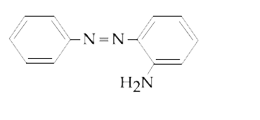An acid chloride on reaction with H2/Pd−BaSO4 gives (CH3)2CHCHO this acid chloride on reaction with dimethyl cadmium in the presence of dry ether , gives :
(CH3)3COH
(CH3)2CHOH
(CH3)2CHCOCH3
(CH3)2CHCHO
The correct Answer is:C
To solve the problem step by step, we will analyze the reactions mentioned in the question.
Step 1: Identify the Acid Chloride
The question states that an acid chloride reacts with H2Pd−BaSO4 to give (CH3)2CHCHO. This product is isobutyraldehyde (or 2-methylpropanal).
- The structure of isobutyraldehyde is:
CH3∣CH3−C−CHO
Step 2: Determine the Structure of the Acid Chloride
Since the product of the reduction is isobutyraldehyde, we can deduce that the acid chloride must be derived from it. The acid chloride that would yield isobutyraldehyde upon reduction is isobutyryl chloride.
- The structure of isobutyryl chloride is:
CH3∣CH3−C−COCl
Step 3: Reaction with Dimethyl Cadmium
Next, we need to consider the reaction of isobutyryl chloride with dimethyl cadmium in the presence of dry ether. Dimethyl cadmium (C2H6Cd) is a nucleophile and will react with the acid chloride to form a tertiary alcohol.
- The reaction can be represented as:
CH3−C(=O)Cl+(CH3)2Cd→CH3−C(OH)(CH3)2+CdCl2
Step 4: Determine the Final Product
The product formed from this reaction is a tertiary alcohol, specifically 3-methyl-2-butanol.
- The structure of 3-methyl-2-butanol is:
CH3|CH3−C−CHOH|CH3
Step 5: Nomenclature of the Final Product
The final product can be named as follows:
- The longest carbon chain contains 4 carbons (butane).
- The hydroxyl group (OH) is on the second carbon.
- There is a methyl group on the third carbon.
Thus, the IUPAC name of the product is 3-methyl-2-butanol.
Final Answer
The compound formed when isobutyryl chloride reacts with dimethyl cadmium in the presence of dry ether is 3-methyl-2-butanol.
---
The question states that an acid chloride reacts with H2Pd−BaSO4 to give (CH3)2CHCHO. This product is isobutyraldehyde (or 2-methylpropanal).
CH3∣CH3−C−CHO
Since the product of the reduction is isobutyraldehyde, we can deduce that the acid chloride must be derived from it. The acid chloride that would yield isobutyraldehyde upon reduction is isobutyryl chloride.
CH3∣CH3−C−COCl
Next, we need to consider the reaction of isobutyryl chloride with dimethyl cadmium in the presence of dry ether. Dimethyl cadmium (C2H6Cd) is a nucleophile and will react with the acid chloride to form a tertiary alcohol.
CH3−C(=O)Cl+(CH3)2Cd→CH3−C(OH)(CH3)2+CdCl2
The product formed from this reaction is a tertiary alcohol, specifically 3-methyl-2-butanol.
CH3|CH3−C−CHOH|CH3
The final product can be named as follows:
- The longest carbon chain contains 4 carbons (butane).
- The hydroxyl group (OH) is on the second carbon.
- There is a methyl group on the third carbon.
The compound formed when isobutyryl chloride reacts with dimethyl cadmium in the presence of dry ether is 3-methyl-2-butanol.
Topper's Solved these Questions
- BOOK - MODERN PUBLICATIONCHAPTER - ALDEHYDES ,KETONES AND CARBOXYLIC ACIDSEXERCISE - COMPETITION FILE ( OBJECTIVE TYPE QUESTIONS - MULTIPLE CHOICE QUESTIONS (MCQ) ( B. MULTIPLE CHOICE QUESTIONS )86videos
ALDEHYDES ,KETONES AND CARBOXYLIC ACIDS
- BOOK - MODERN PUBLICATIONCHAPTER - ALDEHYDES ,KETONES AND CARBOXYLIC ACIDSEXERCISE - COMPETITION FILE ( OBJECTIVE TYPE QUESTIONS - MULTIPLE CHOICE QUESTIONS (MCQ) ( C. MULTIPLE CHOICE QUESTIONS )10videos
ALDEHYDES ,KETONES AND CARBOXYLIC ACIDS
- BOOK - MODERN PUBLICATIONCHAPTER - ALDEHYDES ,KETONES AND CARBOXYLIC ACIDSEXERCISE - HOTS HIGHER ORDER THINKING SKILLS15videos
ALDEHYDES ,KETONES AND CARBOXYLIC ACIDS
- BOOK - MODERN PUBLICATIONCHAPTER - ALCOHOLS, PHENOLS AND ETHERSEXERCISE - UNIT PRACTICE TEST (FOR BOARD EXAMINATION)12videos
ALCOHOLS, PHENOLS AND ETHERS
- BOOK - MODERN PUBLICATIONCHAPTER - BIOMOLECULESEXERCISE - UNIT PRACTICE TEST FOR BOARD EXAMINATION13videos
BIOMOLECULES
Similar Questions
Knowledge Check
- Question 1 - Select One
Benzene diazonium chloride on reaction with aniline in the presence of dilute hydrochloric acid gives :
A B
B C
C D
D
- Question 2 - Select One
Ethyl chloride on reaction with chlorobenzene in presence of Sodium and ether gives:
ATolueneBEthaneCPhenyl ethaneDBoth (1) and (2) - Question 3 - Select One
The reaction of biphenyl with HOCl in the presence of a strong acid gives
A B
B C
C D
D
Reaction of aniline with acety1 chloride in the presence of NaOH gives .
View SolutionC2H5MgI reacts with HCOOC2H5 in the presence of dry ether to give
View SolutionBenzenediazonium chloride on reaction with water gives
View Solutionn - propyl chloride reacts with sodium metal in dry ether to give
View SolutionThe reaction of toluene with chlorine in the presence of ferric chloride gives mainly
View Solution
